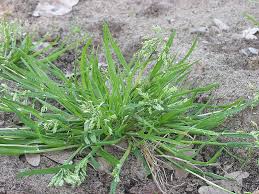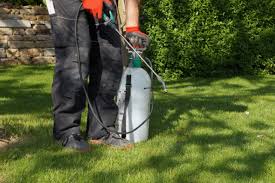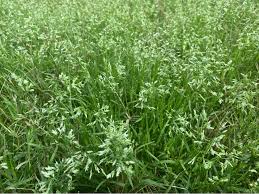Poa annua, also known by its scientific name Poa annua, is a type of grass that people commonly call annual bluegrass or poa. This grass might not look super fancy, but it’s found all over the place, especially in lawns, golf courses, and other places with grass.
Picture this: Poa annua has thin, bright green leaves and special tops where its seeds come out. It really likes soil that’s squished down and not too wet. This grass grows pretty fast and can survive in both cool and kind of in-between climates.
The thing about Poa annua is that it can be a bit of a troublemaker. It’s really good at taking over spaces where other grasses grow. Plus, it makes a lot of seeds, so it spreads around quickly.
People who take care of lawns and grassy places have to work hard to keep Poa annua from causing too much mischief. They try things like cutting the grass at the right height, making sure the soil isn’t too soggy, and poking holes in the ground to help the grass breathe. Sometimes, they even use special stuff to stop Poa annua from growing, but not hurt the good grass.
Even though Poa annua can be a bit of a bother, it’s not all bad. It grows really fast, which can be helpful when you want grass to cover an area quickly. And because it can live in tough places, it’s useful in spots where other grasses might have a tough time.
So, Poa annua might be a little bit tricky, but it’s also kind of cool in its own way. It’s like a grassy survivor that needs some looking after to keep it in check.
Read Also: How often you need to Change Water in your Fish Farm
Growing and Care Guide of Poa Annua

Poa annua, also known as annual bluegrass, can be a charming addition to your lawn or garden if properly managed. Follow these simple steps to successfully grow and care for Poa annua:
1. Choose the Right Location: Poa annua prefers areas with partial to full sun. Make sure the soil is well-draining and not too compacted. It can tolerate a range of soil types but prefers slightly acidic to neutral pH levels.
2. Seeding Time: Late summer to early fall is the best time to sow Poa annua seeds. This allows the grass to establish itself before winter and gives it a head start for the growing season.
3. Seed Preparation: Before seeding, prepare the soil by loosening it using a rake or a mechanical aerator. This helps the seeds to make good contact with the soil.
4. Seeding Technique: Spread the Poa annua seeds evenly over the prepared soil. You can use a spreader to ensure even distribution. Lightly rake the area to cover the seeds with a thin layer of soil.
5. Watering: Keep the seeded area consistently moist, but avoid overwatering which can lead to disease. Watering lightly once or twice a day, depending on the weather, should be sufficient.
6. Germination Period: Poa annua seeds typically germinate within 7 to 21 days. Be patient and keep the soil consistently damp during this period.
7. Mowing: Once the Poa annua reaches a height of around 2 inches, you can start mowing. Set your mower to a height of about 1 to 1.5 inches. Regular mowing helps prevent the grass from going to seed and spreading excessively.
8. Fertilization: Use a balanced fertilizer with equal parts of nitrogen, phosphorus, and potassium to encourage healthy growth. Apply the fertilizer according to the manufacturer’s recommendations, usually during the active growing season.
9. Weed Control: Poa annua can become weedy, so regular maintenance is essential. Hand-pull any unwanted plants and use pre-emergent herbicides in early spring to prevent Poa annua seeds from germinating.
10. Dethatching and Aeration: Over time, thatch (dead grass and roots) can build up and restrict the growth of Poa annua. Dethatch your lawn when needed and consider aerating the soil to improve air and water circulation.
11. Disease and Pest Management: Keep an eye out for diseases like dollar spot or fusarium blight. Use fungicides as needed and ensure good air circulation by not overwatering. Pests are generally not a major issue for Poa annua.
12. Overseeding: In areas with harsh winters, Poa annua may die off. To maintain a green lawn, consider overseeding with Poa annua in the fall.
Remember, Poa annua can be both a friend and a foe in your lawn or garden. Proper care and maintenance will help you harness its benefits while preventing it from becoming overly invasive. Regular monitoring and adjustments to your care routine will ensure a healthy and vibrant outdoor space.
Poa Annua Killer

Poa annua killer is a helpful tool for getting rid of those pesky plants that you don’t want in your yard or garden. These plant killers are designed to target and eliminate poa annua, also known as annual bluegrass, which can sometimes take over your green spaces.
When you notice poa annua sprouting up where it shouldn’t be, a poa annua killer can come to the rescue. These products are formulated to harm the poa annua while leaving your desired plants unharmed. It’s like a superhero for your garden, saving the day from unwanted invaders.
Using a poa annua killer is usually quite simple. You follow the instructions on the product label, which might involve mixing the killer with water in a sprayer. Then, you carefully spray the solution onto the poa annua, making sure not to accidentally hit your other plants. It’s like giving the poa annua a taste of its own medicine!
One important thing to remember is to apply the poa annua killer when the weather is calm. Windy days can cause the spray to drift and accidentally affect plants you want to keep. Also, avoid using the killer on a rainy day, as the rain could wash it away before it has a chance to work its magic.
After you’ve applied the poa annua killer, be patient. It might take a little time for the poa annua to start showing the effects. Eventually, you’ll notice the unwanted plants turning yellow or brown, which means the killer is doing its job. You can then remove the dead poa annua to make space for your preferred plants to thrive.
Remember that poa annua killers are meant to be used specifically for controlling poa annua and should not be applied to other types of grass or plants. It’s important to read and follow the instructions on the product label to ensure effective and safe use.
In addition, if you find yourself facing a poa annua invasion, a poa annua killer can be a valuable tool in your gardening arsenal. By using this targeted solution, you can regain control of your outdoor spaces and create a healthier environment for the plants you love. Just a few sprays, and you’ll be well on your way to a poa annua-free paradise.
Read Also: The Best Source of Water for Fishes in Concrete Ponds
Types of Poa Annua Killer

Poa annua, or annual bluegrass, can sometimes overstay its welcome in lawns and gardens. To combat this invasive weed, various types of poa annua killers are available, each offering a unique approach to tackling the issue. Let’s explore some common types of poa annua killers and how they work:
1. Selective Herbicides: These poa annua killers are designed to target specific plants, like poa annua, while leaving other grasses and plants unharmed. They contain ingredients that focus on the particular characteristics of poa annua, making them a precise option for weed control.
2. Pre-Emergent Herbicides: These poa annua killers work by preventing poa annua seeds from germinating. Applied before the weed starts growing, pre-emergent herbicides form a barrier in the soil that stops poa annua seeds from sprouting, effectively reducing the number of new plants.
3. Post-Emergent Herbicides: These poa annua killers are applied after the weed has already grown. They work by targeting the existing poa annua plants and disrupting their growth processes. Post-emergent herbicides can be selective or non-selective, so it’s important to choose the right type for your needs.
4. Systemic Herbicides: Systemic poa annua killers are absorbed by the weed and then spread throughout the plant, affecting various functions and eventually leading to its demise. These herbicides are effective because they attack the poa annua from the inside out.
5. Non-Selective Herbicides: Unlike selective herbicides, non-selective poa annua killers don’t discriminate – they can harm any plants they come into contact with. These are useful for areas where you want to completely clear out vegetation, but caution is needed to avoid damaging desired plants.
6. Natural and Organic Options: For those who prefer environmentally friendly solutions, natural and organic poa annua killers are available. These often contain plant-based ingredients that target poa annua while minimizing harm to other plants and the ecosystem.
When using poa annua killers, it’s crucial to follow the instructions provided on the product label. Proper application, timing, and dosage are key to achieving the desired results without causing harm to your lawn or garden. It’s also important to note that some poa annua killers may require multiple applications to effectively control the weed.
Before selecting a poa annua killer, consider the specific needs of your lawn or garden, the severity of the poa annua infestation, and your preferences for environmental impact. With the right approach, you can successfully manage poa annua and create a healthier and more vibrant outdoor space.
Read Also: Definition of Environmental Safety: A Comprehensive Guide
